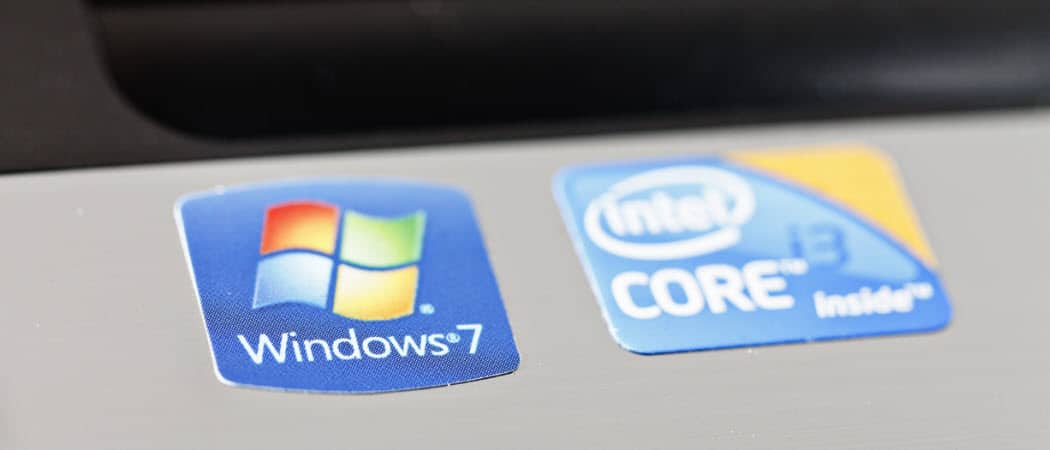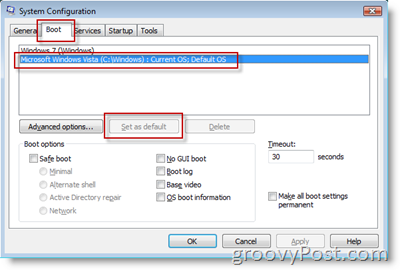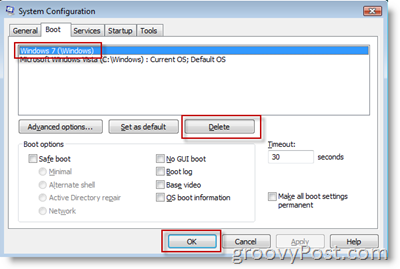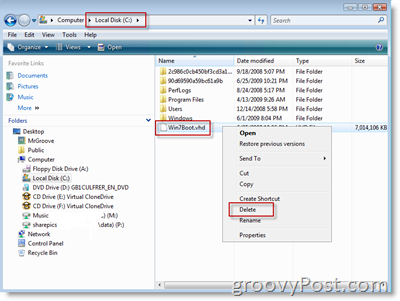A few weeks back I explained how to install Windows 7 in a Dual-Boot Configuration using a VHD file like the Windows 7 System Drive. A few days later I explained how to make Windows 7 in a Dual Boot scenario the primary boot OS. Now after receiving about 20 emails on the topic from readers, I guess it’s time to explain how to undo or delete the Windows 7 Dual Boot configuration. My guess is the testing is done and they are going to wait for the gold bits for Windows 7. So, let’s get right to it. For your convenience, I’ve included not only the step-by-step instructions but also a how-to video.
How-To Remove an OS from Windows Dual Boot Config Screencast Video
How-To Remove an OS from Windows Dual Boot Config [Step-by-Step]
1. Boot into the Non-Windows 7 OS (original OS before you installed Windows 7 as a dual-boot). For most people, this would mean booting into your Vista install however I’m going to guess there might be a few who set up a Dual-Boot config with Windows 2008 also (me for instance). 2. Click the Windows Start button and type msconfig and press Enter (or click it with the mouse)
2. Click Boot Tab, click the OS you want to keep, and click Set as default
3. Click Windows 7 OS and click Delete. Click OK
What you just did was remove Windows 7 from the Windows Boot manager so now it will no longer show up when you boot the computer. Essentially, the computer is no longer a Dual-Boot System (2 Windows Versions installed). The next steps are to just simply delete the Windows 7 VHD file.
Once you delete the Windows 7 VHD file all remnants of Windows 7 will be gone. Hopefully, this is how you installed Windows 7. If not, you will need to go to the System drive you installed Windows 7 and manually delete all the files and folders there. Be careful not to remove anything needed by the current/original OS you want to keep. If you didn’t install Windows 7 in a VHD file, hopefully, you installed it on its own drive so you can just format it. Let me know no module name found aborted operating system not found huhu this thing suckss me..can anyone tell me what to do? do i need it to repormate my netboook i have so many files and document that havent save… plsss am begging you guyzzz pls help me… QUESTION: what will i do to stop the system asking about to choose the OS “””i mean, to run the system continue without asking? because the other WINDOW is already exist..””in short–to run the system originally””””like what they did before, when it was a single OS, like a new Buy…. i hope you get/understand clearly…………….. “looking forward” For some reason, I aborted the procedure, but I was left with a dual-boot menu on startup — my normal XP Home, and some abbreviated XP. Every time I booted, for the last few years, I had to babysit the computer through the POST*, wait for the dual-boot menu, change the selection to the “original XP Home,” and then hit enter. Without intervention, it would try booting into the newer XP entry by default, and Windows would fail to load. So I had to babysit the computer through the POST so I could select the “proper XP” in the dual-boot menu. POST — “Power Up Self Test;” the BIOS stuff before Windows actually starts loading. I had googled the problem a few times over the years, but nothing worked until today, thanks to Goovypost’s step-by-step. There are a half-dozen additional, cryptic lines in my computer’s MSConfig that Mr. Groovy doesn’t show in his Step-By-Step. But one line in my MSConfig had text that matched the desired entry in the dual-boot menu — the one I needed to become Default. I was able to select that line and click on “Make Default.” And viola, no more dual boot! Thanks Mr. Groove! Regarding those other lines in my MSConfig, I was unable to select any of the other lines. If I clicked on any other line, the line that I needed to be selected would highlight, anyway. If that makes any sense. Anyway, I recognized the line I needed because it included a phrase that matched the valid entry in the dual-boot menu, and I was able to highlight it and click Make Default. So, nice to finally be done with that Dunsel dual-boot screen, and not have to babysit the computer through the POST, anymore. *Dunsel — describes a part which serves no useful purpose. —— If I didn’t babysit the computer, it would always “automatically” choose the invalid XP entry from the dual-boot menu, and then fail to boot. One thing I did over the years was to increase the “timeout” before the computer would automatically select the invalid XP entry. It started at 30 seconds or something like that, and if I didn’t intervene, it would try to boot the invalid entry, fail, and sit there and do nothing. That’s why I was forced to babysit. I was able to increase the timeout from 30 seconds to 999 seconds. Sorry I don’t remember how I did that; maybe it was a function in MSConfig? At least if I turned my back for a minute during the POST, I’d still have a chance to select the correct dual-boot entry when I had 999 seconds to catch it. ——- On that note, if I understand correctly, there are some entries around the web describing methods to reduce the dual-boot-menu timeout to 0 seconds. The suggestion was deadly for me because I needed time to choose the non-default dual-boot item. With the timeout period set to 0 seconds, I was left with No Time to make the proper dual-boot selection. Then, I was locked out of my computer, or at least I could never get a chance to select the desired non-default dual-boot menu item. That happened to me. Zero seconds, and the only thing my computer could do was the “invalid boot.” Out of desperation, I danced on the F8 key after starting the computer, and after the POST I was able to get some selection that included getting back into the dual-boot menu. Maybe it was the “Last Valid Startup” menu item that got me a valid boot-up. Then I think I was able to go back into MS Config and change that 0-second-timeout to the Maximum Allowed Value. But I did want to dope-slap the person that suggested reducing the timeout to Zero seconds and giving me one big, extra headache. I guess if the default dual-boot selection is your desired selection, then Zero seconds is a good thing. But a Zero-second timeout is not a good thing if the desired dual-boot selection leads to a failed boot-up. People suggesting a Zero-second boot-up should consider that when they’re giving advice. I wrote:
But a Zero-second timeout is not a good thing if the desired dual-boot selection leads to a failed boot-up. What I meant to write is that a Zero-second timeout is not a good thing if the DEFAULT selection leads to a failed boot-up. Sigh. #ItsEasierWithAnEditButton I hope we’re still groovy. -neil-
![]()





